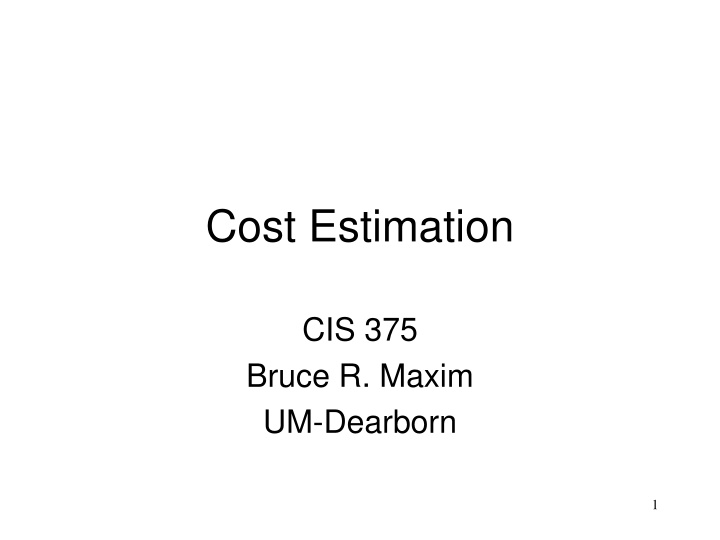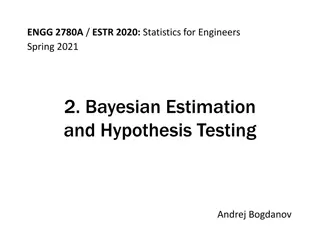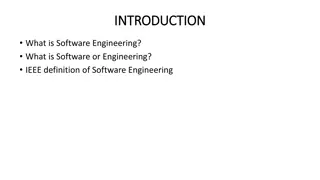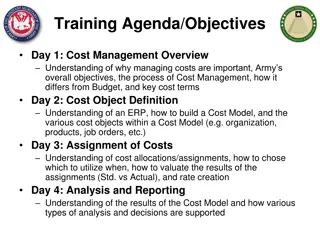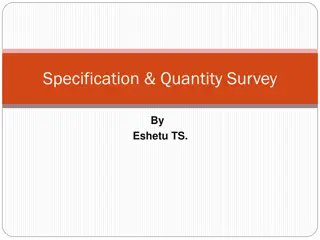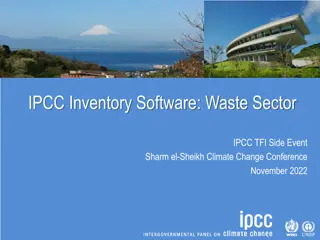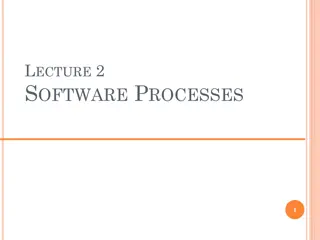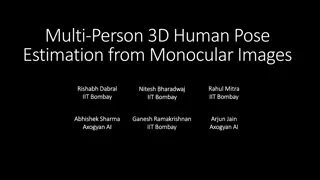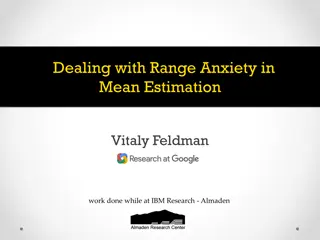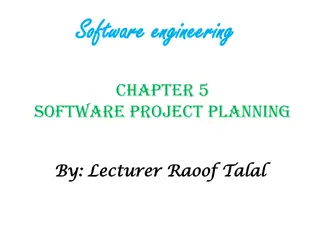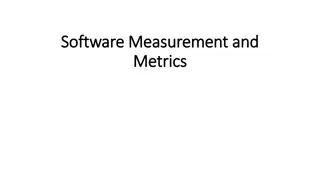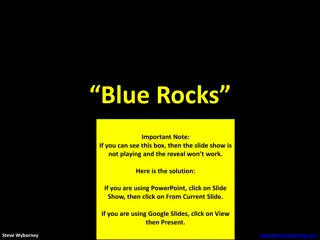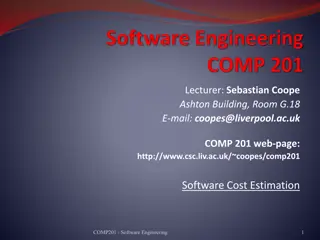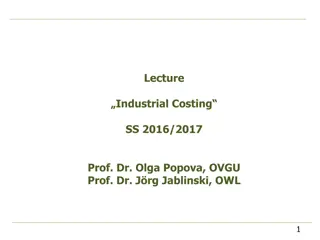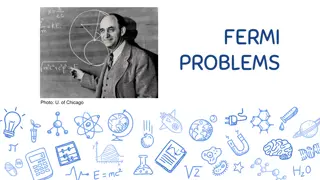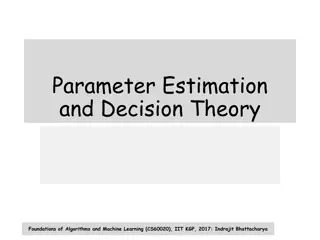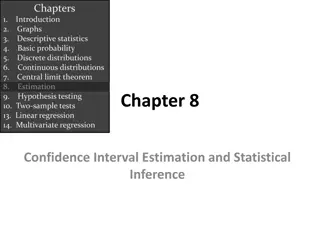Software Development Cost Estimation Best Practices
Explore key principles and techniques for accurate cost estimation in software development projects. Discover the importance of the 5WHH principle, management spectrum, critical practices, resource estimation, estimation options, and decomposition techniques for improved project planning. Learn about empirical estimation models and how they contribute to better decision-making in software development.
Download Presentation

Please find below an Image/Link to download the presentation.
The content on the website is provided AS IS for your information and personal use only. It may not be sold, licensed, or shared on other websites without obtaining consent from the author.If you encounter any issues during the download, it is possible that the publisher has removed the file from their server.
You are allowed to download the files provided on this website for personal or commercial use, subject to the condition that they are used lawfully. All files are the property of their respective owners.
The content on the website is provided AS IS for your information and personal use only. It may not be sold, licensed, or shared on other websites without obtaining consent from the author.
E N D
Presentation Transcript
Cost Estimation CIS 375 Bruce R. Maxim UM-Dearborn 1
5WHH Principle Why is the system being developed? What will be done and When? Who is responsible for a function? Where are they organizationally located? How will the job be done technically and managerially? How much of each resource is needed? 2
Management Spectrum People Product Process Project 3
Critical Practices Formal risk management Empirical cost and schedule estimation Metric-based project management Earned value tracking Defect tracking against quality targets People-aware program management 4
Resource Estimation Human Resources number of people required and skills needed to complete the development project Project Methods and Tools Reusable Software Resources off-the-shelf components modifiable components new components Development Environment hardware and software required during the development process 5
Estimation Options Delay estimation until late in the project. Base estimates on similar projects already completed. Use simple decomposition techniques to estimate project cost and effort. Use empirical models for software cost and effort estimation. Automated tools may assist with project decomposition and estimation. 6
Decomposition Techniques -1 Software sizing fuzzy logic function point calculation standard component %change Process-based estimation decomposition based on tasks required to complete the software process framework 7
Decomposition Techniques - 2 Problem-based estimation using lines of code (LOC) decomposition focuses on software functions using function point (FP) decomposition focuses on information domain characteristics 8
Empirical Estimation Models Experiential Models Typically derived from regression analysis of historical software project data with estimated person-months as the dependent variable Static Estimation Model does not include time as an independent variable Constructive Cost Model (COCOMO) Dynamic Estimation Models usually takes time or development phase into account Software Equation Model 9
Expert Guessing A = The most pessimistic estimate. B = The most likely estimate. C = The most optimistic estimate. = (A + 4B + C) 6 (Weighted average; where = estimate). 10
Delphi Technique 1. Group of experts, make "secret" guesses. 2. "secret" guesses are used to compute group average. 3. Group average is presented to the group. 4. Group, once again makes "secret" guesses. 5. Individual guesses are again averaged. 6. If new average is different from previous, then goto (4). 7. Otherwise = new average. 11
Scrum Poker Story Points Each team member given cards with a range of values (e.g. 1, 2, 3, 5, 8, 13, 21, 40, 100, ?) Product owner reads Product Backlog Item Each team member plays card face down All cards turned over at the same time If they match that is the value If they do not match high and low bidders need to explain the reasoning Each member plays card with their new bid 12
Problems with Expert Judgement It is subjective. (consensus is difficult to achieve) Extrapolating from one project to another may be difficult. Users and project managers tend not to estimate costs very well. Cost matrices require periodic updates. 13
Process Measurement Wherever possible quantitative process data should be collected Organizations without process standards may have to be define processes before measurements can be made (since they won t know what to measure) Process measurements should be used to assess process improvements Organization objectives drive process improvement, not measurements
Process Measurement Classes Time taken to complete process activities e.g. calendar time to complete a milestone Resources required to complete processes or activities e.g. person months Number of event occurrences e.g. number of defects found Product Size e.g. lines of code (LOC)
Example: Building Costs Problem The builder needs to know the floor area (in sq. ft.) to estimate the cost of construction. Clients normally cannot describe their needs in square feet. They usually can describe the type and number of rooms they want. Solution Use rooms as a proxy for size. Use historical (typical) data to translate from rooms to square feet.
Example: Customer Requirements Bedrooms: 1 large, 2 medium, and 1 small Bathrooms: 1 large and 2 medium Kitchen: 1 medium Living room: 1 large Dining room: 1 medium Family room: 1 large Utility: 1 medium
Historical Building Data Small Medium Large Bedrooms 90 140 200 Bathrooms 25 60 120 Kitchens 100 130 160 Living rooms 150 250 400 Dining rooms 100 140 200 Family rooms 150 240 340 Utility 25 50 80
Proxy Calculation Bedroom 1 large = 1 x 200 = 200 Bedroom 2 medium = 2 x 140 = 280 Bedroom Bathroom Bathroom Kitchen Living room Dining room Family room Utility 1 small 1 large 2 medium 1 medium 1 large 1 medium 1 large 1 medium = = = = = = = = Total (sq. ft.) 1 x 1 x 120 2 x 1 x 130 1 x 400 1 x 140 1 x 340 1 x 90 = = = = = = = = = 90 120 120 130 400 140 340 50 60 50 1870
Software Product Proxies Classes, functions, and procedures Product elements database elements screens, reports, scripts, files book chapters Lines of code
Example C++ Class Size Ranges LOC per item L VS S VL Type M 2.34 5.13 11.25 24.66 54.04 Calculation Data 2.60 4.79 8.84 16.31 30.09 9.01 12.06 16.15 21.62 28.93 I/O Logic 7.55 10.98 15.98 23.25 33.83 3.88 5.04 6.56 8.53 11.09 Set-up Text 3.75 8.00 17.07 36.41 77.66
Example: Size Estimation Problem Software engineer needs to know the size of a program (in LOC) to estimate the costs prior to submitting a bid. Clients normally cannot describe their needs in LOC. They usually can describe the input/output screens and the types of calculations (but not the details). Solution Use classes as a proxy for size. Use historical (typical) data to translate from classes to lines of code (LOC).
Customer Requirements MPG App Input screen: Output screen: Calculation: 1 large 1 very large 1 small Input 1 large = 1 x 21.62 = 21.62 Output 1 very large = 1 x 30.09 = 30.09 Calculation 1 small = 1 x 2.34 = 5.13 Total (LOC) = 56.84
Function Points Parameter Simple + Average + Complex = Fi Distinct input items 3( ) + 4( ) + 6( ) = ? Output screens/reports 4( ) + 5( ) + 7( ) = ? Types of user queries 3( ) + 4( ) + 6( ) = ? Number of files 7( ) + 10( ) + 15( ) = ? External interface 5( ) + 7( ) + 10( ) = ? = Total ? 24
Function Point Questionnaire 1. 2. 3. 4. 5. Backup. Data communication. Distributed processes. Optimal performance. Heavily used operating system. On-line data security. Multiple screens. On-line master file update. 9. Complex inputs, queries, outputs. 10. Complex internal processing. 11. Reusable code. 12. Conversion or installation. 13. Multiple user sites. 14. Ease of use. 6. 7. 8. 25
Function Point Equation http://groups.umd.umich.edu/cis/course.des/cis375/projects/fp99/main.html F.P. s = T * (0.65 + 0.01 * Q) T = unadjusted table total Q = score from questionnaire (14 items with values 0 to 5) Cost of producing one function point? May be organization specific. 26
Converting LOC to Person Months Programmers are not usually paid per line of code produced Some people write tighter code that others You would not want to pay for unneeded code Some programming languages provide more powerful statements than others LOC is does not directly help us estimate the time it takes but can be equated to person months Person months are typically more useful to project managers
COCOMO - I Effort in person months = a Sb * m(x) S measured in KLOC = LOC/1000 BASIC INTERMEDIATE MODE a b a b Organic 2.4 1.05 3.2 1.05 Semidetached 3.0 1.12 3.0 1.12 Embedded 3.6 1.20 2.8 1.20 28
Basic COCOMO Computes software development effort (and cost) as a function of program size, expressed in estimated lines of code. m(x) = 1 29
Basic COCOMO/SemiDetached E = a Sb * m(x) person months E = 3.0 (56.87/1000.0)1.12 * (1.0) person months E = 3.0 (0.403) = 0.1209 person months 1 person month = 8 hrs/day * 21 days/month = 168 hrs E = 0.1209 * 168 = 20.31 hrs http://groups.umd.umich.edu/cis/course.des/cis525/js/f00/kutcher/kutcher.html 9/18/2024 30
Static Linear Models Often built using regression analysis Effort = c0 + ci * xi C = regression coefficient X = product or process attribute 31
Static Non-Linear Models Examples Effort = c0 + ci * xidi Cianddi are non-linear regression constants or Effort = (a + b S C) * m(X) where S is size in KLOC a, b, and c are regression constants http://groups.umd.umich.edu/cis/course.des/cis525/js/f00/gamel/cocomo.html 32
Intermediate COCOMO Computes software development effort as a function of program size and a set of "cost drivers" that include subjective assessments of product, hardware, personnel, and project attributes. m(x) = m(xi) 33
Static Model Problems Existing models rely at least in part on expert judgment Most static estimates require estimation of the product in lines of code (LOC) Not clear which cost factors are significant in all development environments 35
Dynamic Models It is helpful to know when effort will be required on a project as well as how much total effort is required Most models are time or phase sensitive in their effort computations COCOMO2 does this http://csse.usc.edu/csse/research/COCOMOII/cocomo_main.html 36
COCOMO II Allows one to estimate the cost, effort, and schedule when planning a new software development activity. Consists of three submodels, each one offering increased fidelity the further along one is in the project planning and design process (Applications Composition, Early Design, and Post-architecture). http://csse.usc.edu/tools/COCOMOII.php 37
Make Buy Decision It may be more cost effective to acquire a piece of software rather than develop it. Decision tree analysis provides a systematic way to sort through the make-buy decision. As a rule outsourcing software development requires more skillful management than does in-house development of the same product. 38
Decision Process 1. Develop specifications. 2. Estimate internal cost & delivery. 3. Select 3 or 4 candidate packages. 4. Select reasonable components. 5. Build a cost-benefit comparison matrix (key function performance) or use conduct benchmark tests of candidate software 6. Evaluate each software package or component based on history with the product or vendor. 7. Contact other users. 39
